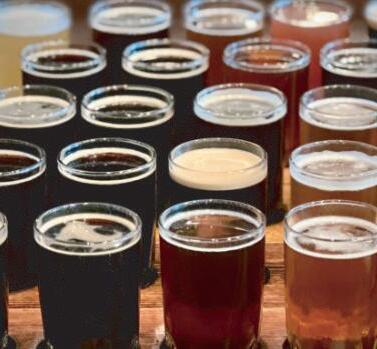













































































































































































A Special Advertising Section of the Bangor Daily News • Friday, July 12, 2024





















































































































































































A Special Advertising Section of the Bangor Daily News • Friday, July 12, 2024






By Emily Baer
Imagine you’re looking for a new beer to try. You scan your options, amazed and overwhelmed. Finally, something catches your eye. It’s the style of the beer, the logo and brewery, and the art on the label. Everything about that particular product matches what you’re looking for, and you’ve made your decision.
That moment is hard earned, as savvy product designers spend a lot of time thinking about how to attract customers and represent their products. It is both a science and an art.

In 2018, international marketing research company IPSOS found that 72% of consumers see product packaging as a key factor in what drives their purchases. In marketing psychology textbooks, there are countless examples of how thoughtful branding can help define and sustain businesses. Across industries, brand recognition is the number one indicator of long term success. In niche food and beverage markets, standing out from the crowd is a matter of life or death.
Maine’s craft beer scene has enjoyed a surge in interest over the last decade, and while that continues today, there has been a shift in the market. Attracting and retaining customers is slightly more challenging than it was pre-pandemic, especially with strong national and regional competition.
“Some breweries can get buried by the mass of beers that are available,” says Aaron James, Beer Manager for Damon’s Beverage in Bangor. In order to attract customers’ attention, successful breweries have to make long-term investments to create recognizable, reliable brands.
Successful packaging - or branding - relies on visual appeal, brand recognition, functionality, authenticity, and story. Since beer cans and bottles are fairly uniform, functionality is mostly taken care of. Everything else takes center stage. The label’s fonts, colors, and imagery must all serve the same goal: to build out a brand narrative.
Oftentimes, packaging is designed to match the overall vibe of a brewery. There’s a throughline with the physical space and the products that are sold within it; it all works together to tell a story. That story is as much about the customers as it is about the business. And, as with every story, it evolves over time.
“When it comes to our store, people looking for new beers often look for a can that they haven’t seen before,” says James. They may gravitate towards a brand name they recognize, but likely want something new and different from that brewery.

Orono Brewing Company stands out as an example of a Maine brand that is dynamic and experimental while also being recognizable. In large part, that’s due to Creative Director Justin Soderberg’s clean aesthetic and the consistency of his design choices. With bright colors, crisp fonts, and imagery drawn from Maine’s natural beauty, there’s a throwback feel to many of OBC’s labels. You see their cans and you see yourself having fun. Most importantly, their appealing cans are hard to miss. Mason’s Brewing Company in Brewer has also developed remarkable brand recognition, and a legion of similarly loyal fans. Drawing on pop culture references, heavy metal music, folklore, and comic book culture, their
cans are bold and illustrative. There’s an epicness to their aesthetic, something that is also reflected in the name of each new beer. Their labels feature work by Ben Bishop, an illustrator whose work is well known by comic book lovers in Maine and beyond, or New Hampshire-based artist Gary Freeman. In both instances, the artists collaborate with owner and brewer Chris Morley to develop a unique and creative vision for new products.
On the other end of the visual spectrum are breweries like Ellworth’s Fogtown Brewing Company. Their labels tend to rely on simple, artistic renditions of local landmarks, Maine iconography, and nature-inspired designs. By relying on a quirky, out of the box aesthetic that pairs vivid colors, hand drawn elements, and their signature script, they have created a brand that is nimble yet recognizable. Customers know to expect the unexpected, and they love it.

As the state’s craft-beer scene continues to grow and change, so too will the branding choices that breweries make to stand out and stay strong in rapidly evolving markets. Creativity and collaboration are at the heart of the scene, and that’s true both in terms of the product breweries put out and the way they market their beers. When it comes to beer, we have an embarrassment of riches in Maine, and, lucky for us, it’s a real feast for the eyes too.








By Callie Picard




Maine is home to some of the most unique fruit wines in the United States. Its climate and fertile soil support a variety of fruits beyond the traditional grape vineyards found in many wine-producing regions. Local growers supply an abundance of fresh apples, blueberries, raspberries, strawberries, cranberries and elderberries for wine making. The variety of native fruits serves as the foundation for Maine’s flourishing fruit wine industry.
The following are just a few of the Maine-made fruit wines that I’d like to showcase.
Bartlett Winery - Gouldsboro, ME
Bartlett Wild Blueberry Wine is crafted using locally sourced Maine wild blueberries. These berries are known for their intense flavor and deep blue-purple color, which are carefully preserved through the winemaking process to capture the essence of fresh-picked fruit.
Perfectly balanced and aged, this wild blueberry wine is not overly tart, but also not too sweet. Full bodied and smooth, it’s natural acidity pairs well with local game or a sharp aged cheddar and is best enjoyed at room temperature.
If you tend to enjoy sweeter wines, Bartlett also offers a Sweet and Semi-Sweet Wild Blueberry Wine.
You can explore more about Bartlett Winery and their variety of berry wines at http://www.bartlettwinery.com/index.html
Eighteen Twenty Winery - Portland, ME
This wine is crafted using locally sourced rhubarb, a vegetable known for its tart flavor
and vibrant pink hue. Rhubarb provides a distinctive character to the wine, offering a refreshing and slightly tangy taste that sets it apart from traditional grape wines.
Féte is a dry and lighter alternative to their equally refreshing “Victoria’’ rhubarb wine. It exhibits a bright acidity balanced with light notes of citrus, strawberry, and hints of earthiness. This wine pairs well with a white sauce pasta dish, local seafood, a fresh salad, or even cheesecake. Féte is light and airy, making it the perfect summer wine. Best enjoyed chilled.
Learn more about Eighteen Twenty Winery and their unique rhubarb wines at https://www.eighteentwentywines.com/.
Fresh and fragrant, this wine is an easy sip. It exhibits a delicate balance of sweetness and acidity, with the natural flavors of ripe pears shining through. It often features fruity notes reminiscent of pear nectar, complemented by subtle floral undertones that add complexity to the palate.
This wine’s versatile character makes it suitable for a variety of culinary pairings. Its crisp acidity and fruit-forward profile make it an excellent complement to dishes such as seafood, poultry, and salads. It also pairs well with soft cheeses and desserts like pear tart or poached pears in wine sauce.
Find out more about Tree Spirits Winery and their refreshing wines online at https://treespiritsofmaine.com/
These wines are just a fraction of the unique fruit wines that Maine wineries have to offer. I would encourage you to explore Maine’s wineries and vineyards and experiment with pairing wines with local cuisine and recipes. Take the opportunity to experience the essence of Maine’s various landscapes through a glass. You won’t be disappointed! Cheers!

Courtesy of Metro Creative
The craft beer boom has inspired millions of people to look at beer through a new lens. Once relegated to backyard barbecues and ballgames, beer is now served alongside gourmet meals. Much like the right wine can make a meal taste even better, beer can bring out the flavors of food, making it an ideal complement to anything from steak to seafood to salad.
The Brewers Association is an American trade group whose membership consists of more than 5,400 brewers, suppliers and retailers. The group recommends beer lovers follow a three-pronged approach to matching beer and food. It’s worth noting the BA does not view this approach as a 1-2-3 process, meaning beer lovers need not follow the steps in order to perfect their pairing skills.
Match strength with strength. The BA recommends pairing strongly flavored foods with assertive beers and delicate foods with delicate beers. For example, a relatively low alcohol witbier should pair well with light seafood like steamed mussels. Beer lovers who enjoy strong barley wines, which are typically 10 percent alcohol by volume (ABV) or higher, should find that a strong cheese or dessert matches up well with this overpowering style.
2. Find harmonies. The BA notes that beer-food combinations typically resonate most effectively when they share some common flavor or aroma element. The BA points to how the deep, roasted flavors of an imperial stout often pair nicely with chocolate truffles.
3. Consider sweetness, bitterness, carbonation, heat (spice), and richness. The BA recommends that beer lovers look to take advantage of the specific and predictable ways that certain qualities of food and beer interact with each other. For example, malty sweetness can cool the heat, making a hoppy beer with plenty of malt a good choice to pair with spicy food.
Want to pair your favorite craft beers like an old pro at home or at your local pub with an extensive tap list? Consider these pairing recommendations, courtesy of the Brewers Association.
Witbier: Lighter seafood dishes like steamed mussels
Blonde ale: Light food, including chicken, salads & salmon
India Pale Ale: Strong spicy food & bold, sweet desserts like carrot cake
Double/Imperial IPA: Smoked beef brisket, grilled lamb & southern chicken-fried steak
Amber/red ale: Chicken, seafood, burgers, & spicy cuisine
Porter: Barbecue, sausages, roasted meat,& blackened fish
Sweet or Oatmeal stout: Rich, spicy food, including barbecued beef & Szechuan cuisine
Classic pilsner: Light food such as chicken, salads & salmon
American wheat ale: Very light food, including salads, sushi & vegetable dishes
Abbey dubbel: Barbecue, meat stews, & a thick, hearty steak











Widely available and incredibly popular, Cabernet Sauvignons are typically bold wines that are rich in flavor. Cabernet Sauvignons are derived from a full-bodied red grape, which is why they are often described as “full-bodied.” Tannins are a naturally occurring polyphenol found in plants and seeds that are predominantly in red wines, and those in Cabernet Sauvignons are bold. Some Cabernet Sauvignons elicit tastes similar to baking spices, while others may taste more like black cherry or black currant.
Another popular, widely available varietal, Pinot Noirs boast a low tannin finish that gives them a fruity taste reminiscent of cherry or cranberry. Pinot Noirs are light-bodied and smooth. The alcohol content in Pinot Noirs tends to be lower than that of a typical Cabernet Sauvignon.

Rieslings are white wines that are popular thanks in large part to their sweetness and floral, citrus taste. Rieslings are a go-to option when pairing wines with certain ethnic cuisine, including Indian, Thai and Vietnamese dishes. Some Rieslings can be dry, so wine enthusiasts looking for Rieslings for their sweetness may want to speak with a representative at the winery to ensure they’re getting the wine they want.
Another wildly popular red wine, Merlots have an extensive flavor profile. Some Merlots may produce a taste reminiscent of black cherries, while others may provide strong hints of cocoa. Merlots are typically made in a dry style, and they are easily mistaken for Cabernet Sauvignons.

































































Courtesy of Metro Creative

Millions of people are interested in brewing their own beer at home. Craft brewing may start as a hobby or curiosity, and once successful, turn into something individuals do again and again. While it’s possible to eventually make money by brewing, most people engage this hobby for the pride that ensues after sipping their own ales, pilsners and stouts and sharing them with friends and family.
Those ready to engage in home brewing will be happy to learn that there are plenty of resources available for getting started. Even with a simple set-up, it’s possible to brew a decent beer. Here are the items to consider.
• Brew pot: Home brewers will need something in which to boil the wort, which will eventually become the beer. This vessel should be made of aluminum, stainless steel or enamel-coated aluminum and be large enough to handle the size batch of beer.
• Fermenter: Fermenter vessels will hold the beer while it is going through the fermentation process. Food-grade plastic buckets or glass carboys are options. The fermenter should seal tightly to keep out air and microorganisms, but have a space for an airlock that will allow the carbon dioxide to escape.
• Tubing and siphon: A siphon and vinyl tubing is needed to rack the beer from one fermenter to the next or from the fermenter to bottles.
• Hydrometer: A hydrometer, according to Beer Tola, a resource on brewing and beverages, is a tool that measures the density of liquid, known as specific gravity. This helps one calculate when fermentation is complete as well as the alcohol content of the finished product.






Sanitation is essential when brewing, and all equipment needs to be sanitized correctly so that the beer is not introduced to microorganisms that can affect taste or even the fermentation process. Only the yeast used for fermentation should be present. Many experienced brewers say that sanitation is the most important part of the process. Brew shops sell specialized chemicals for sanitizing all equipment, but some home brewers also stand by boiling water for cleaning gear.
The basics of beer recipes include hops, grains, water, and yeast. When the hops and grains are boiled down, one has wort, which essentially is sugar water. The yeast will feed on this sweetened water to produce carbon dioxide through fermentation.






The beer-making process is one any beer lover can explore. And with so many beer kits for sale with step-by-step instructions, any initial foray into brewing beer can be successful.

















Courtesy of Metro Creative
eer has been produced by humans for longer than many people may know. Barley beer researchers have to traced beer production to present-day Iran in the fifth millennium BC. The making and drinking of beer also is noted in the written history of ancient Egypt and Mesopotamia.
Beer is one of the most popular alcoholic beverages available today and it is an important sector of the beverage industry. Business Insider says an estimated $661 billion worth of beer was sold around the world in 2017. In the United States alone, more than 7,000 new breweries opened in 2018, according to the Brewers Association. An additional 1,000 breweries were expected to open in 2019.
All beers are either lagers or ales, which are distinguished by the type of yeast used during the fermentation process (bottom- or top-fermenting, respectively). These beers are further labeled to describe the brew’s overall character, and oftentimes its place of origin, states BeerAdvocate.
The following are some of the most popular types of beers on the market
Bocks: BeerAdvocate says a German Bock is a lager that is stronger than your typical lager, with a more robust malt character. The hue of these beers ranges from dark amber to brown. Bocks were once brewed by Bavarian monks and were consumed at the end of Lent.
Brown ales: These beers feature toasty flavors with malty overtones. They have a mid-range alcohol content and boast a hoppy bitterness. Brown ales are fullbodied beers that pair well with heavier foods, like red meats and stews.
Dark lagers: Many dark lagers have malty, smooth, caramel flavors. They tend to have a mid-range alcohol level and relatively low bitterness profiles.
India pale ales: IPAs boast strong hop bitterness and piney, floral flavors. They are especially popular among craft beer enthusiasts and brewers. IPAs tend to have a higher alcohol content than other pale ales. Imperial or double IPAs have even more pronounced flavors and higher ABVs.
Pale ales: These beers are hoppy, but generally light, drinkable beers. Many easily pair with fish, poultry and cheeses.
Pilsners and pale lagers: These similar, golden-colored beers are light in flavor and lower in alcohol content than other styles of beer. This style of beer was made popular in Germany, but many American brands like Coors and Budweiser have made pale lagers a favorite of the masses.

Porters: Porters were developed in London in the early 18th century. These beers are well-hopped and dark in appearance due to the use of brown malt. The name grew from the popularity of the beer among street and river porters.
Stouts: Stouts tend to be dark in color and are often mistaken as being heavy and strong. This isn’t always the case. Many stouts are complex and low in alcohol, according to All About Beer magazine. Dry stouts are well-known in Ireland. A distinguishing characteristic of a dry stout is its black, essentially opaque appearance.














































































